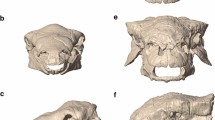Abstract
The relationship between jaw and skull morphology and feeding type (grazer, mixed feeder, browser, frugivorous, omnivorous) was analysed in 94 species of extant ungulates. A total of 21 morphological traits of the jaw and skull (17 and 4, respectively) were analysed using analysis of covariance, with body mass as covariate. To take into account the phylogenetic effect, simulations were generated under the Brownian motion model of character evolution. Analysis of covariance was applied to these simulations and the simulated F-ratios were used to assess the signification of the F-ratios for the real values of the traits. The feeding types had a weak effect on ungulate cranial and jaw morphology in comparison with the phylogenetic effect, since, before phylogeny correction, the analysis of covariance showed statistically significant differences associated with feeding type in 15 out of the 21 traits analysed. After controlling for phylogeny, only 2 significant traits remained, the length of the coronoid process and the occipital height. Omnivorous species had shorter coronoid processes than grazers or mixed feeders, and the occipital height was greater in the omnivorous species than in the grazers, mixed feeders or browsers. The coronoid process is involved in the generation of bite force, being the effective moment arm of the temporalis muscle, and occipital height is positively related to the force exerted by the temporalis muscle. This result matches the hypothesis that species with a toughness diet should show higher bite force (“toughness” describes the resistance of a material to being mechanically broken down). When the omnivorous species were excluded from the analysis, no differences in jaw and skull morphology were detected between the rest of the feeding types.
Similar content being viewed by others
Author information
Authors and Affiliations
Additional information
Received: 1 September 1998 / Accepted: 2 November 1998
Rights and permissions
About this article
Cite this article
Pérez-Barbería, F., Gordon, I. The functional relationship between feeding type and jaw and cranial morphology in ungulates. Oecologia 118, 157–165 (1999). https://doi.org/10.1007/s004420050714
Issue Date:
DOI: https://doi.org/10.1007/s004420050714




